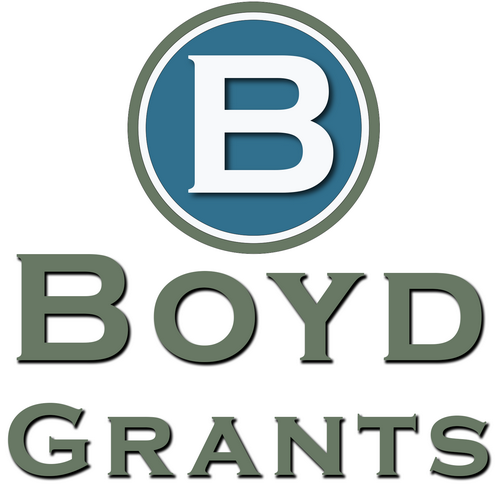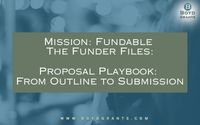Hello, Fundable Friends!
In the last two issues, we cracked the code on funder language and priorities. Now it’s time to turn that intel into action, by crafting proposals that get noticed, read thoroughly, and ultimately, funded.
Whether you’re a first-time writer or a seasoned grant pro, the proposal writing process can feel overwhelming. Today, we break it down into clear, manageable steps with tips, tools, and strategies designed to help you build a compelling case without losing your mind.
Let’s make your next proposal not just good, but unignorable.
📋 Deep Dive: The Anatomy of a Fundable Proposal
A winning proposal is more than just filling out a form. It’s a strategic story told in sections, each answering a key question the funder has on their mind.
Here’s your detailed playbook:
1. Cover Letter / Executive Summary
Purpose: Your first impression. A quick snapshot that answers: Who are you? What do you want? Why should we care?
- Keep it under one page and write it last (after the full proposal is done).
- Use the funder’s language, mirror keywords, but stay authentic.
- Highlight the impact and alignment with the funder’s goals upfront.
- Include a call to action or an offer to provide more information.
Example phrase:
“We are excited to present a program that directly advances [Funder Name]’s commitment to empowering underserved youth through innovative leadership development.”
2. Statement of Need / Problem Description
Purpose: Show you understand the problem and why it’s urgent.
- Use credible data: statistics, reports, and localized info if possible.
- Add qualitative elements: personal stories, quotes, or community voices.
- Connect the problem clearly to the funder’s priorities.
- Avoid generic claims, make it specific and relatable.
Example:
“Despite an increase in local educational funding, over 40% of youth in [Neighborhood] lack access to after-school programs, disproportionately impacting youth of color.”
3. Project Description: Goals and Objectives
Purpose: What you plan to do and what success looks like.
- Goals: Broad statements of intended impact (qualitative).
- Objectives: Specific, measurable targets (quantitative). Use SMART criteria.
- Use bullet points for clarity.
SMART Objective example:
“By June 2025, increase the high school graduation rate of program participants by 15% compared to baseline.”
4. Methods / Approach
Purpose: How you will get it done.
- Break down activities step-by-step (workshops, outreach, mentoring).
- Explain the why behind your approach, what evidence or best practices support it?
- Highlight partnerships and roles clearly.
- Be realistic, avoid overpromising.
Example:
“Our program incorporates a peer mentorship model proven to increase youth engagement, delivered in partnership with [Local High School] and [Community Center].”
5. Evaluation Plan
Purpose: How you will measure progress and demonstrate success.
- Specify indicators: attendance, surveys, test scores, community feedback.
- Outline data collection methods and frequency.
- Explain how results will inform program improvements.
- Show commitment to transparency and accountability.
Example:
“Quarterly surveys and biannual focus groups will assess changes in youth leadership skills and school attendance.”
6. Budget and Justification
Purpose: Show that you understand what it costs to deliver your program and why each expense matters.
- Present a clear, itemized budget aligned with activities.
- Include personnel, materials, travel, evaluation, and indirect costs.
- Justify unusual or high-cost items explicitly.
- Include in-kind contributions or matching funds to show commitment.
Tip: Make sure your budget math adds up perfectly, errors here raise red flags.
7. Organizational Background / Capacity
Purpose: Why you’re the right team to do this work.
- Highlight your organization’s mission, history, and expertise.
- Showcase past successes relevant to the proposal.
- Include bios or qualifications of key staff if requested.
- Mention infrastructure like financial controls or partnerships.
8. Conclusion / Sustainability
Purpose: How your project will live on beyond this grant.
- Describe your plans to sustain activities or outcomes (diverse funding, community buy-in, capacity building).
- Emphasize long-term impact and scalability.
- Leave funders confident their investment will create lasting change.
🛠️ Time-Saving Tips & Tools
Grant writing is a marathon, not a sprint, but you can make it smoother:
- Create templates: Draft reusable boilerplate sections for your organization and common methods.
- Outline first: Sketch your proposal structure to focus writing and avoid tangents.
- Use bullet points and headings: Improve readability and highlight key info.
- Set mini-deadlines: Break down your process and schedule review times.
- Proofread early: Fresh eyes catch errors and help clarify messaging.
- Track funder guidelines carefully: Each funder has unique formatting and length rules, follow them exactly.
🛰️ Funding Intel Brief: What Funders Really Want
💡 Clarity, Focus, and Confidence
Funders skim dozens or hundreds of proposals. They want:
- Easy-to-understand narratives with clear structure.
- Evidence you know the problem and have a feasible solution.
- Concrete plans with measurable outcomes.
- Budgets that match activities.
- Proof your organization can deliver.
Avoid jargon, fluff, and vague promises. Make it easy for funders to say YES.
💬 Mission Debrief: Your Turn
What’s your biggest proposal pain point?
Is it writing objectives, budgeting, or something else?
Reply here or comment below, I’ll share advice and examples in upcoming issues.
🔭 Next Month’s Issue Preview:
“Grant Calendar Mastery: How to Plan, Track, and Win More Grants”
Master your deadlines and organize your grant pipeline with smart calendar strategies and tools.
Until next time, keep writing smart, and stay Mission: Fundable.
— Allison Boyd | Boyd Grants


Recent Comments